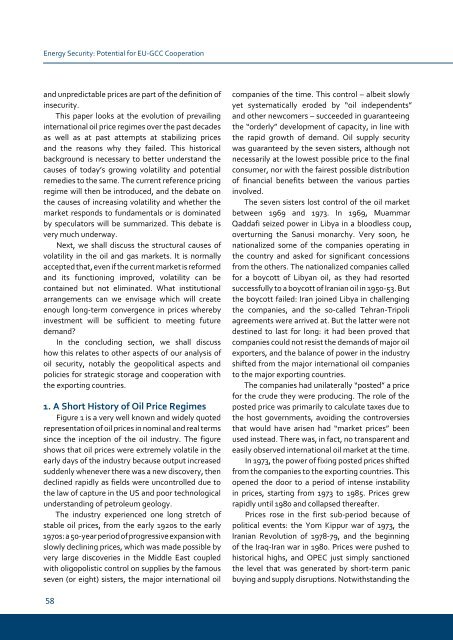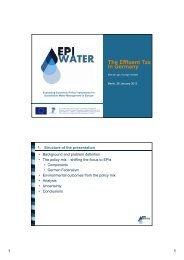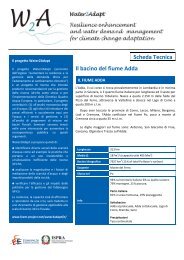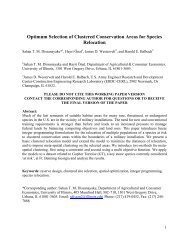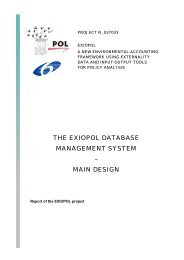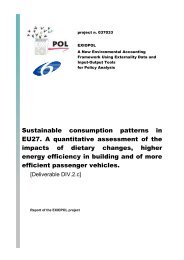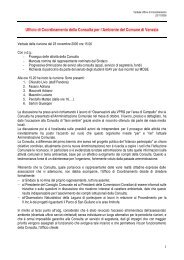Gulf and European Energy Supply Security - Feem-project.net
Gulf and European Energy Supply Security - Feem-project.net
Gulf and European Energy Supply Security - Feem-project.net
You also want an ePaper? Increase the reach of your titles
YUMPU automatically turns print PDFs into web optimized ePapers that Google loves.
<strong>Energy</strong> <strong>Security</strong>: Potential for EU-GCC Cooperation<br />
<strong>and</strong> unpredictable prices are part of the definition of<br />
insecurity.<br />
This paper looks at the evolution of prevailing<br />
international oil price regimes over the past decades<br />
as well as at past attempts at stabilizing prices<br />
<strong>and</strong> the reasons why they failed. This historical<br />
background is necessary to better underst<strong>and</strong> the<br />
causes of today’s growing volatility <strong>and</strong> potential<br />
remedies to the same. The current reference pricing<br />
regime will then be introduced, <strong>and</strong> the debate on<br />
the causes of increasing volatility <strong>and</strong> whether the<br />
market responds to fundamentals or is dominated<br />
by speculators will be summarized. This debate is<br />
very much underway.<br />
Next, we shall discuss the structural causes of<br />
volatility in the oil <strong>and</strong> gas markets. It is normally<br />
accepted that, even if the current market is reformed<br />
<strong>and</strong> its functioning improved, volatility can be<br />
contained but not eliminated. What institutional<br />
arrangements can we envisage which will create<br />
enough long-term convergence in prices whereby<br />
investment will be sufficient to meeting future<br />
dem<strong>and</strong>?<br />
In the concluding section, we shall discuss<br />
how this relates to other aspects of our analysis of<br />
oil security, notably the geopolitical aspects <strong>and</strong><br />
policies for strategic storage <strong>and</strong> cooperation with<br />
the exporting countries.<br />
1. A short History of oil Price Regimes<br />
Figure 1 is a very well known <strong>and</strong> widely quoted<br />
representation of oil prices in nominal <strong>and</strong> real terms<br />
since the inception of the oil industry. The figure<br />
shows that oil prices were extremely volatile in the<br />
early days of the industry because output increased<br />
suddenly whenever there was a new discovery, then<br />
declined rapidly as fields were uncontrolled due to<br />
the law of capture in the US <strong>and</strong> poor technological<br />
underst<strong>and</strong>ing of petroleum geology.<br />
The industry experienced one long stretch of<br />
stable oil prices, from the early 1920s to the early<br />
1970s: a 50-year period of progressive expansion with<br />
slowly declining prices, which was made possible by<br />
very large discoveries in the Middle East coupled<br />
with oligopolistic control on supplies by the famous<br />
seven (or eight) sisters, the major international oil<br />
companies of the time. This control – albeit slowly<br />
yet systematically eroded by “oil independents”<br />
<strong>and</strong> other newcomers – succeeded in guaranteeing<br />
the “orderly” development of capacity, in line with<br />
the rapid growth of dem<strong>and</strong>. Oil supply security<br />
was guaranteed by the seven sisters, although not<br />
necessarily at the lowest possible price to the final<br />
consumer, nor with the fairest possible distribution<br />
of financial benefits between the various parties<br />
involved.<br />
The seven sisters lost control of the oil market<br />
between 1969 <strong>and</strong> 1973. In 1969, Muammar<br />
Qaddafi seized power in Libya in a bloodless coup,<br />
overturning the Sanusi monarchy. Very soon, he<br />
nationalized some of the companies operating in<br />
the country <strong>and</strong> asked for significant concessions<br />
from the others. The nationalized companies called<br />
for a boycott of Libyan oil, as they had resorted<br />
successfully to a boycott of Iranian oil in 1950-53. But<br />
the boycott failed: Iran joined Libya in challenging<br />
the companies, <strong>and</strong> the so-called Tehran-Tripoli<br />
agreements were arrived at. But the latter were not<br />
destined to last for long: it had been proved that<br />
companies could not resist the dem<strong>and</strong>s of major oil<br />
exporters, <strong>and</strong> the balance of power in the industry<br />
shifted from the major international oil companies<br />
to the major exporting countries.<br />
The companies had unilaterally “posted” a price<br />
for the crude they were producing. The role of the<br />
posted price was primarily to calculate taxes due to<br />
the host governments, avoiding the controversies<br />
that would have arisen had “market prices” been<br />
used instead. There was, in fact, no transparent <strong>and</strong><br />
easily observed international oil market at the time.<br />
In 1973, the power of fixing posted prices shifted<br />
from the companies to the exporting countries. This<br />
opened the door to a period of intense instability<br />
in prices, starting from 1973 to 1985. Prices grew<br />
rapidly until 1980 <strong>and</strong> collapsed thereafter.<br />
Prices rose in the first sub-period because of<br />
political events: the Yom Kippur war of 1973, the<br />
Iranian Revolution of 1978-79, <strong>and</strong> the beginning<br />
of the Iraq-Iran war in 1980. Prices were pushed to<br />
historical highs, <strong>and</strong> OPEC just simply sanctioned<br />
the level that was generated by short-term panic<br />
buying <strong>and</strong> supply disruptions. Notwithst<strong>and</strong>ing the


